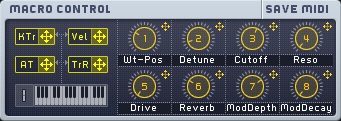Macro Control Section
MASSIVE’s Macro Control section handles incoming MIDI data such as velocity, aftertouch and other MIDI controller information. It is also the most prominent place to work with incoming automation data from a host sequencer program when MASSIVE is used as a plug-in. For conceptual information on how to work with the Macro Controls, see section Macro Controls Automation and MIDI.

There are two types of controls available here.
At the left, there are four small yellow controllers available which can be assigned to modulation destinations in MASSIVE. Each of these routes modulation data triggered by an external MIDI keyboard or MIDI sequence to the modulation target.
KTr (Keytracking): Generates a modulation signal depending on the pitch of the played MIDI note.
TrR (Trigger Random): Each played MIDI note trigger generates a new random value at the output of the TrR modulation source.
AT (Aftertouch): The modulation source provides the aftertouch value of your MIDI messages. Note that relatively few MIDI keyboards send aftertouch information.
Vel (Velocity): This modulation source relays velocity data from your MIDI keyboard or other MIDI controller.
At the right, the eight Macro Controls can be used to unify your interaction with the sound of MASSIVE. They can be controlled easily by external MIDI knobs or faders: Right-click one of the Macro Controls and select MIDI Learn from the context menu. Then move your external controller’s knob or fader to make the assignment. While this can be done with all of MASSIVE’s parameters, the Macro Controls will probably be your favorite target. Once you have made your MIDI assignments, click SAVE MIDI to store them in the currently active MIDI setup template. For more information about MIDI templates see The Standalone Menus.
You will find that most of the preset sounds included in MASSIVE’s library already have assignments made to the eight Macro Control Knobs, allowing you to easily assign external MIDI controls to them and start tweaking and changing the sound in creatively useful ways. The exact assignments for each preset will vary, but in general they conform to the following pattern. Note that you can assign these knobs to control whatever parameters you want; the descriptions below reflect only the typical settings of the presets in the MASSIVE sound library.
Oscillator (Macro 1 and 2): Settings related to the oscillator section are generally assigned to these first two knobs. Examples: WT-position, Intensity, Pitch (for chords etc.)
Spectrum (Macro 3 and 4): This column usually controls settings related to the frequency domain, i.e. anything that changes the sound's spectrum. Examples: Filter Cutoff, Phase distortion level
FX (Macro 5 and 6): Effect-related settings are typically assigned to knobs 5 and 6. The dry/wet parameters of active effects are often assigned to Control knob 5. The other Control knob may be assigned to other effect parameters such as effect time, feedback, and so on.
Motion/Time (Macro 7 and 8): These controls are related to the time domain, i.e. anything that changes the sound in time. Parameters such as modulation speed and intensity or the LFO or Stepper Rate may be assigned here. Examples: Rate/Amp of LFO/Env/Stepper/Performer, Morph speed, Envelope amount.
Note that the Macro Controls will appear (along with all of MASSIVE’s other controls) as automatable parameters in a host sequencer. Thus, you can modulate them with recorded MIDI data in your sequence. You can directly automate any of MASSIVE’s various controls directly from your sequence as well, but making the assignment via the Macro Controls opens up a number of new creative possibilities as described in section Macro Controls Automation and MIDI.
Please refer to your host’s documentation on information about its automation capacities. There it will be explained how to access MASSIVE’s parameters from inside your host application.